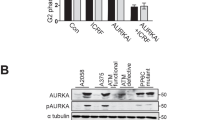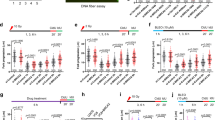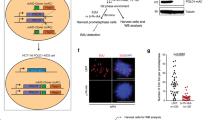Abstract
When exposed to ionizing radiation (IR), eukaryotic cells activate checkpoint pathways to delay the progression of the cell cycle1,2,3. Defects in the IR-induced S-phase checkpoint cause ‘radioresistant DNA synthesis’, a phenomenon that has been identified in cancer-prone patients suffering from ataxia-telangiectasia, a disease caused by mutations in the ATM gene4,5,6. The Cdc25A phosphatase7 activates the cyclin-dependent kinase 2 (Cdk2) needed for DNA synthesis8,9, but becomes degraded in response to DNA damage10 or stalled replication11. Here we report a functional link between ATM, the checkpoint signalling kinase Chk2/Cds1 (Chk2)12 and Cdc25A, and implicate this mechanism in controlling the S-phase checkpoint. We show that IR-induced destruction of Cdc25A requires both ATM and the Chk2-mediated phosphorylation of Cdc25A on serine 123. An IR-induced loss of Cdc25A protein prevents dephosphorylation of Cdk2 and leads to a transient blockade of DNA replication. We also show that tumour-associated Chk2 alleles13 cannot bind or phosphorylate Cdc25A, and that cells expressing these Chk2 alleles, elevated Cdc25A or a Cdk2 mutant unable to undergo inhibitory phosphorylation (Cdk2AF) fail to inhibit DNA synthesis when irradiated. These results support Chk2 as a candidate tumour suppressor, and identify the ATM–Chk2–Cdc25A–Cdk2 pathway as a genomic integrity checkpoint that prevents radioresistant DNA synthesis.
This is a preview of subscription content, access via your institution
Access options
Subscribe to this journal
Receive 51 print issues and online access
We are sorry, but there is no personal subscription option available for your country.
Buy this article
- Purchase on SpringerLink
- Instant access to full article PDF
Prices may be subject to local taxes which are calculated during checkout





Similar content being viewed by others
References
Weinert, T. DNA damage and checkpoint pathways: molecular anatomy and interactions with repair. Cell 94, 555–558 (1998).
Hartwell, L. H. & Kastan, M. B. Cell cycle control and cancer. Science 266, 1821–1828 (1994).
Elledge, S. J. Cell cycle checkpoints: preventing an identity crisis. Science 274, 1664–1672 (1996).
Painter, R. B. & Young, B. R. Radiosensitivity in ataxia-telangiectasia: a new explanation. Proc. Natl Acad. Sci. USA 77, 7315–7317 (1980).
Rotman, G. & Shiloh, Y. ATM: a mediator of multiple responses to genotoxic stress. Oncogene 18, 6135–6144 (1999).
Stewart, G. S. et al. The DNA double-strand break repair gene hMRE11 is mutated in individuals with an ataxia-telangiectasia-like disorder. Cell 99, 577–587 (1999).
Galaktionov, K. & Beach, D. Specific activation of cdc25 tyrosine phosphatases by B-type cyclins: evidence for multiple roles of mitotic cyclins. Cell 67, 1181–1194 (1991).
Hoffmann, I., Draetta, G. & Karsenti, E. Activation of the phosphatase activity of human cdc25A by a cdk2-cyclin E dependent phosphorylation at the G1/S transition. EMBO J. 13, 4302–4310 (1994).
Jinno, S. et al. Cdc25A is a novel phosphatase functioning early in the cell cycle. EMBO J. 13, 1549–1556 (1994).
Mailand, N. et al. Rapid destruction of Cdc25A in response to DNA damage. Science 288, 1425–1429 (2000).
Molinari, M. et al. Human Cdc25A inactivation in response to S phase inhibition and its role in preventing premature mitosis. EMBO Reps 1, 71–79 (2000).
Matsuoka, S., Huang, M. & Elledge, S. J. Linkage of ATM to cell cycle regulation by the Chk2 protein kinase. Science 282, 1893–1897 (1998).
Bell, D. W. et al. Heterozygous germ line hCHK2 mutations in Li–Fraumeni syndrome. Science 286, 2528–2531 (1999).
Gu, Y., Rosenblatt J. & Morgan, D. O. Cell cycle regulation of CDK2 activity by phosphorylation of Thr160 and Tyr15. EMBO J. 11, 3995–4005 (1992).
Boddy, M. N., Furnari, B., Mondesert, O. & Russell, P. Replication checkpoint enforced by kinases Cds1 and Chk1. Science 280, 909–912 (1998).
Furnari, B., Rhind, N. & Russell, P. Cdc25 mitotic inducer _targeted by chk1 DNA damage checkpoint kinase. Science 277, 1495–1497 (1997).
Peng, C. Y. et al. Mitotic and G2 checkpoint control: regulation of 14-3-3 protein binding by phosphorylation of Cdc25C on serine-216. Science 277, 1501–1505 (1997).
Sanchez, Y. et al. Conservation of the Chk1 checkpoint pathway in mammals: linkage of DNA damage to Cdk regulation through Cdc25. Science 277, 1497–1501 (1997).
Zeng, Y. et al. Replication checkpoint requires phosphorylation of the phosphatase Cdc25 by Cds1 or Chk1. Nature 395, 507–510 (1998).
Chehab, N. H., Malikzay, A., Appel, M. & Halazonetis, T. D. Chk2/hCds1 functions as a DNA damage checkpoint in G1 by stabilizing p53. Genes Dev. 14, 278–288 (2000).
Sun, Z., Hsiao, J., Fay, D. S. & Stern, D. F. Rad 53 FHA domain associated with phosphorylated Rad9 in the DNA damage checkpoint. Science 281, 272–274 (1998).
Durocher, D., Henckel, J., Fersht, A. R. & Jackson, S. P. The FHA domain is a modular phosphopeptide recognition motif. Mol. Cell 4, 387–394 (1999).
Hirao, A. et al. DNA damage-induced activation of p53 by the checkpoint kinase Chk2. Science 287, 1824–1827 (2000).
Chan, T. A., Hermeking, H., Lengauer, C., Kinzler, K. W. & Vogelstein, B. 14-3-3σ is required to prevent mitotic catastrophe after DNA damage. Nature 401, 616–620 (1999).
Giaccia, A. J. & Kastan, M. B. The complexity of p53 modulation: emerging patterns from divergent signals. Genes Dev. 12, 2973–2983 (1998).
Lim, D. S. et al. ATM phosphorylates p95/nbs1 in an S-phase checkpoint pathway. Nature 404, 613–617 (2000).
Xie, G. et al. Requirements for p53 and ATM gene product in the regulation of G1/S and S phase checkpoints. Oncogene 16, 721–736 (1998).
Galaktionov, K. et al. CDC25 phosphatases as potential human oncogenes. Science 269, 1575–1577 (1995).
Lee, J. S., Collins, K. M., Brown, A. L., Lee, C. H. & Chung, J. H. hCds1-mediated phosphorylation of BRCA1 regulates the DNA damage response. Nature 404, 201–204 (2000).
Santoni-Rugiu, E., Falck, J., Mailand, N., Bartek, J & Lukas, J. Involvement of Myc activity in a G1/S-promoting mechanism parallel to the pRb/E2F pathway. Mol. Cell. Biol. 20, 3497–3509 (2000).
Acknowledgements
We thank S. Elledge, G. Evan, S. I. Reed and Y. Shiloh for providing reagents; K. Hansen for advice; and the Danish Cancer Society, the Human Frontier Science Programme, Alfred Benzon's Fund, the European Commission, the Danish Medical Research Council and the Danish Cancer Research Fund for financial support.
Author information
Authors and Affiliations
Corresponding author
Rights and permissions
About this article
Cite this article
Falck, J., Mailand, N., Syljuåsen, R. et al. The ATM–Chk2–Cdc25A checkpoint pathway guards against radioresistant DNA synthesis. Nature 410, 842–847 (2001). https://doi.org/10.1038/35071124
Received:
Accepted:
Issue Date:
DOI: https://doi.org/10.1038/35071124
This article is cited by
-
BPA induces placental trophoblast proliferation inhibition and fetal growth restriction by inhibiting the expression of SRB1
Environmental Science and Pollution Research (2023)
-
Acetylation dependent translocation of EWSR1 regulates CHK2 alternative splicing in response to DNA damage
Oncogene (2022)
-
Natural podophyllotoxin analog 4DPG attenuates EMT and colorectal cancer progression via activation of checkpoint kinase 2
Cell Death Discovery (2021)
-
Epigenetic based synthetic lethal strategies in human cancers
Biomarker Research (2020)
-
Comparison of the different mechanisms of cytotoxicity induced by checkpoint kinase I inhibitors when used as single agents or in combination with DNA damage
Oncogene (2020)



